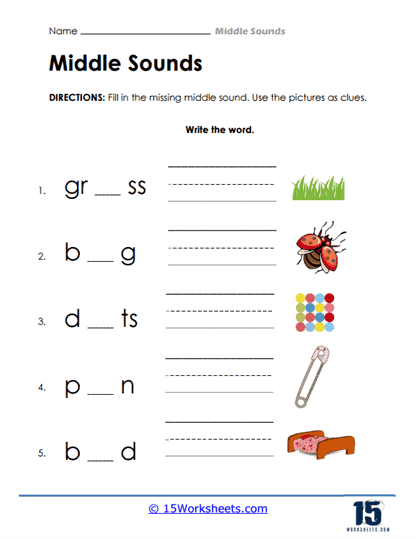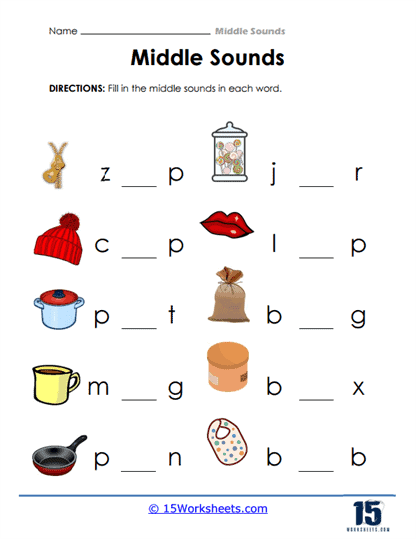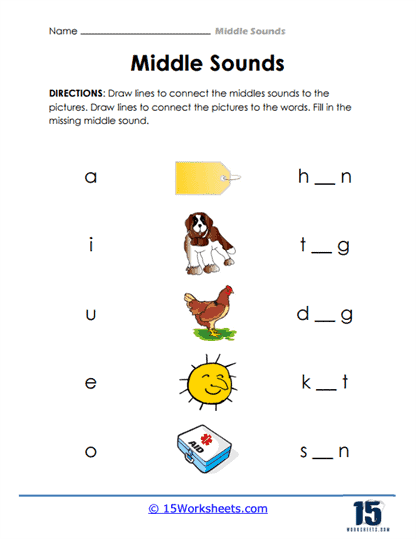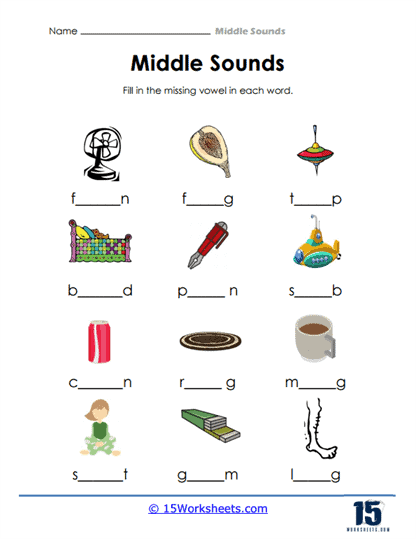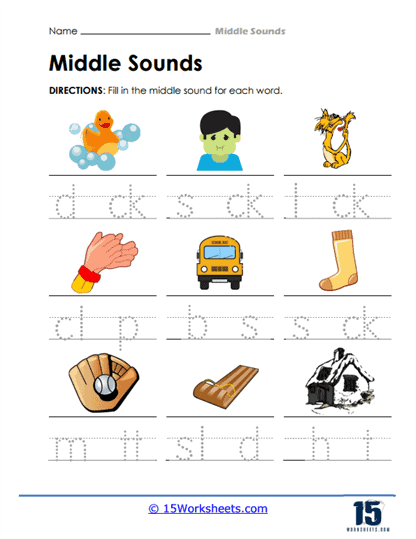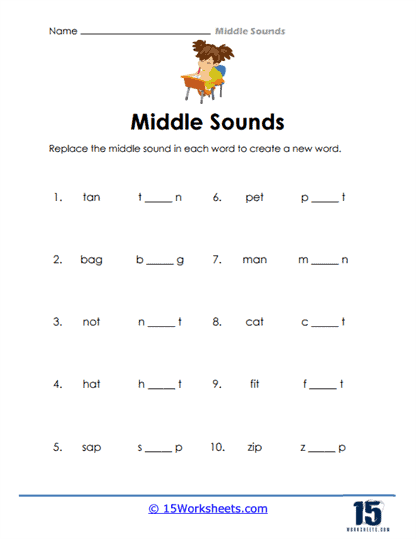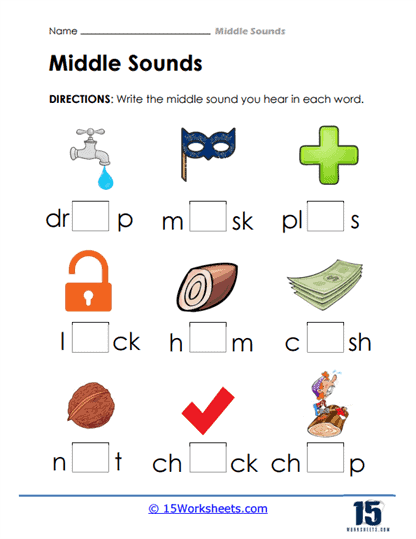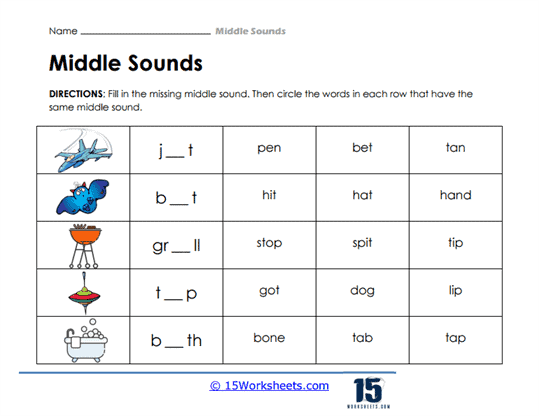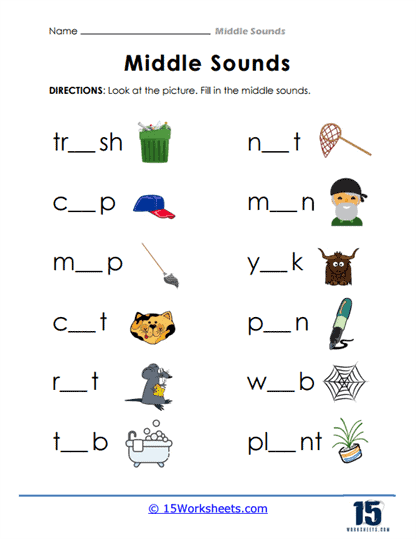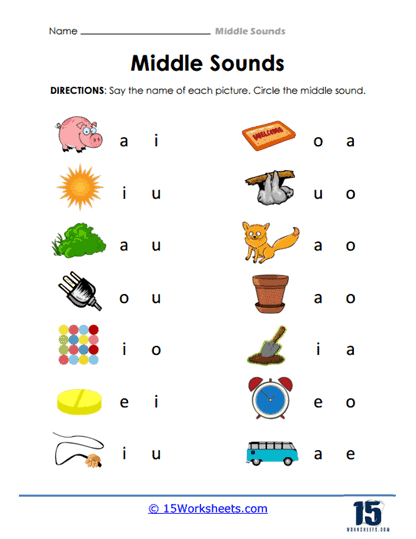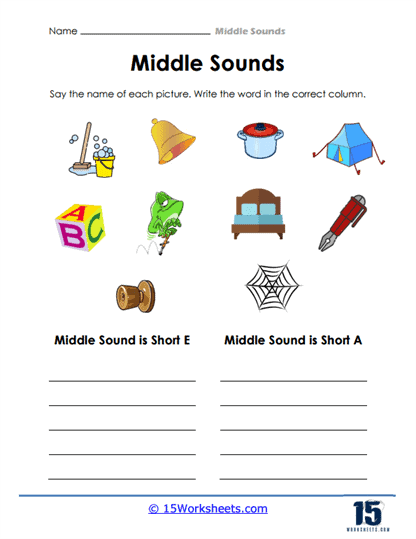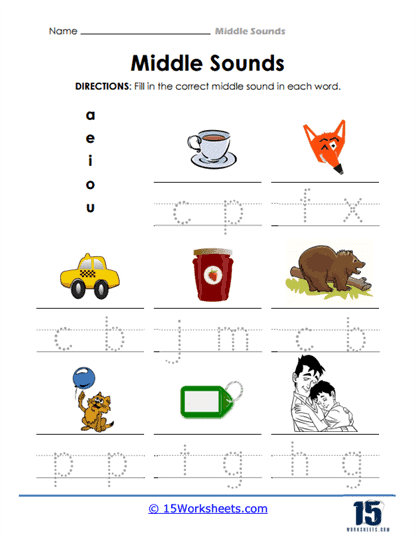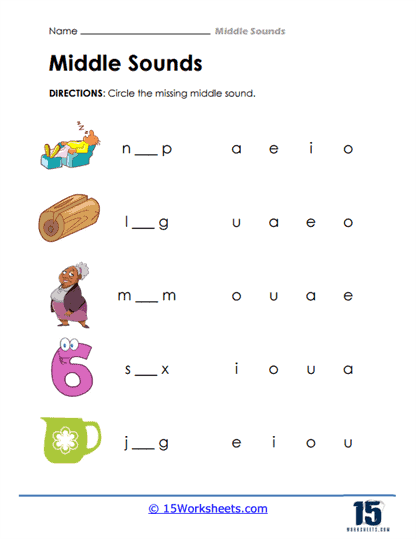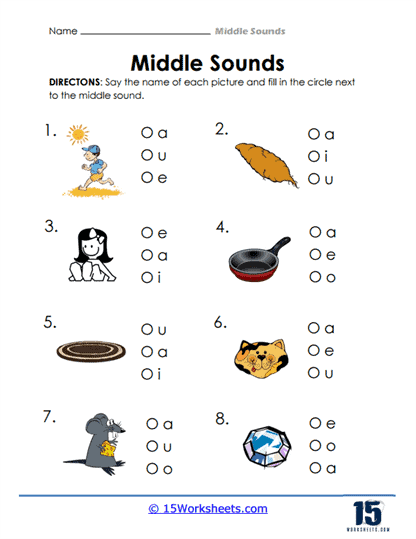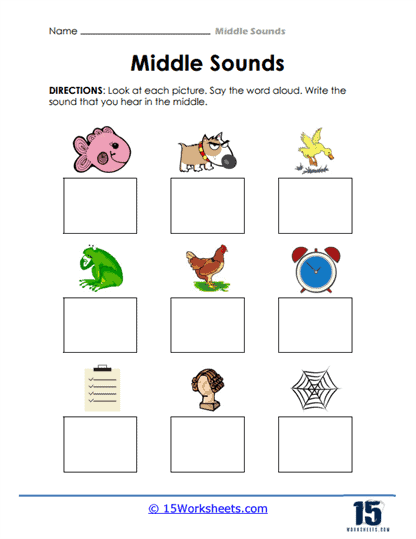Middle Sounds Worksheets
All About These 15 Worksheets
Middle Sounds Worksheets are an essential component in a child’s journey toward becoming a proficient reader and confident communicator. These carefully designed educational tools play a pivotal role by helping young learners recognize and master the crucial vowel sounds nestled between the initial and final consonants of words. For example, the short ‘a’ sound in “cat” or the long ‘o’ sound in “dog” are key to understanding how words are formed and pronounced. Mastering these middle sounds represents a critical milestone in literacy development, providing a foundational skill set for advanced reading comprehension, spelling accuracy, and articulate verbal expression. When children grasp the significance of these vowel sounds, they gain not only practical reading skills but also an important boost in confidence, which further enhances their overall ability to decode unfamiliar words and improves the fluidity of their reading experience.
The importance of mastering middle sounds is deeply rooted in the concept of phonemic awareness, which is a fundamental aspect of early literacy education. Phonemic awareness refers to the ability to hear, distinguish, and manipulate the individual sounds-or phonemes-that make up spoken words. Developing this awareness is key to becoming a skilled reader. Middle Sounds Worksheets provide a structured yet accessible approach to honing this ability, as they focus on what can be a particularly challenging aspect of phonemic awareness: recognizing and differentiating vowel sounds. Unlike consonants, vowel sounds are often more subtle, nuanced, and variable. This complexity requires students to engage in targeted, repeated practice to sharpen their listening and decoding skills. By regularly working with Middle Sounds Worksheets, students become more adept at distinguishing between vowel sounds, which directly contributes to their reading fluency and overall comprehension, laying the groundwork for more complex literacy tasks.
In addition to their educational value, our collection of worksheets has been thoughtfully designed to appeal to a wide range of learning styles, ensuring that students remain engaged while learning. The variety of activities included-such as matching vowel sounds to corresponding pictures, sorting words based on their middle sounds, and writing exercises that emphasize the critical role of vowels-provides diverse opportunities for students to interact with and absorb the material. For younger learners, visual aids and interactive tasks are particularly effective in maintaining their attention and interest, while older students benefit from exercises that require them to identify and analyze patterns in vowel sounds across different words. This multifaceted approach not only makes the learning process enjoyable but also deepens students’ understanding of how vowel sounds function within words. The goal is to transform what could be a dry phonics exercise into an engaging and dynamic experience, one that motivates students to actively participate and succeed in mastering middle sounds.
The flexibility of these worksheets makes them a valuable resource for both teachers and parents. In the classroom, these worksheets can be seamlessly integrated into a broader phonics curriculum, serving as a complementary tool that reinforces lessons on vowel sounds and phonemic awareness. Teachers can use them in group activities, as part of literacy centers, or even as independent practice for students. Parents, on the other hand, can use these worksheets at home to provide additional support for their child’s reading development. With clear instructions and a variety of exercises, these worksheets allow children to practice independently while still gaining meaningful exposure to vowel sounds. This flexibility empowers both educators and parents to tailor the learning experience to the individual needs of the student, ensuring that each child gets the focused practice they need to improve their reading and speaking abilities. Over time, consistent use of these worksheets will lead to noticeable improvements, giving students the skills and confidence they need to tackle more complex texts with ease.
Middle Sounds Worksheets serve as an invaluable bridge between the basic recognition of letters and the more advanced understanding of how those letters combine to form meaningful words. By focusing on the heart of language-vowel sounds-these worksheets give children the tools they need to navigate the challenges of reading. As students grow in their ability to recognize, decode, and apply vowel sounds, they develop stronger literacy foundations that will support them throughout their academic journey and beyond. Whether used as part of a structured classroom curriculum or as supplemental material for home practice, Middle Sounds Worksheets offer a fun, engaging, and effective way to foster literacy skills, ensuring that young learners are equipped for long-term success in reading and communication.
What Are Middle Sounds?
The middle sounds of words refer to the sounds or phonemes that occur between the initial (beginning) and final (ending) sounds in a word. These middle sounds are often represented by vowels or combinations of vowels and consonants. In English, middle sounds can include both short and long vowel sounds, as well as consonant blends and digraphs.
In phonics instruction, middle sounds are essential for teaching children to decode and read words, as well as to segment and spell them. Recognizing and manipulating middle sounds can help learners build their phonemic awareness and develop their reading and writing skills.
Here are a few examples of words with different middle sounds:
“cat” (/kæt/) – The middle sound is the short vowel sound /æ/.
“heat” (/hiːt/) – The middle sound is the long vowel sound /iː/.
“crust” (/krʌst/) – The middle sound is a consonant blend /r/ and the short vowel sound /ʌ/.
“flight” (/flaɪt/) – The middle sound is a consonant blend /l/ and the long vowel sound /aɪ/.
“chew” (/tʃuː/) – The middle sound is the consonant sound /tʃ/ and the long vowel sound /uː/.
Teaching middle sounds involves introducing various vowel sounds, consonant blends, and digraphs, as well as providing ample practice for learners to decode, read, and spell words containing these sounds. Activities that focus on recognizing and manipulating middle sounds can help students build their phonemic awareness and develop essential literacy skills.
The Importance of Middle Sounds
Understanding the role of middle sounds in language is an essential component of literacy and language development, with far-reaching benefits for students. The middle sound in a word-often a vowel or vowel combination-can significantly affect how a word is understood, pronounced, and spelled. When students master middle sounds, they unlock greater proficiency not just in reading, but across various aspects of communication. This seemingly small part of a word can have a huge impact on a student’s academic progress and overall language skills.
First and foremost, middle sounds play a crucial role in reading proficiency. The ability to recognize and correctly pronounce these sounds allows students to decode words more fluently, leading to better comprehension of text. When students are able to break down words into their components-beginning, middle, and end-they can tackle unfamiliar words with confidence. Fluent readers who can handle middle sounds effectively tend to have better overall reading skills, which in turn supports their ability to engage with more complex texts as they progress through their education. Without a firm grasp of these sounds, even capable students can struggle with reading fluency and comprehension.
In addition to reading, spelling competence is directly influenced by a student’s ability to recognize and use middle sounds correctly. Many spelling errors can be traced back to confusion about these sounds. For instance, if a student cannot distinguish between similar-sounding vowels or vowel pairs, they are more likely to misspell words. By mastering middle sounds, students can significantly improve their spelling accuracy. This not only enhances their writing but also boosts their confidence in using language, helping them avoid the frustration that often accompanies frequent spelling mistakes.
Understanding middle sounds contributes to vocabulary building. The more adept students are at distinguishing middle sounds, the more words they are exposed to and able to retain. Expanding vocabulary through the practice of phonics is a key part of developing language skills. As students encounter new words, recognizing familiar sound patterns allows them to infer meaning, understand context, and make connections between words. This, in turn, empowers them to express themselves more precisely and effectively, both in spoken and written forms. A broad vocabulary is a cornerstone of academic success and is critical in developing critical thinking and communication skills.
Proficiency in middle sounds is not just about academic achievement-it is vital for effective communication. A student who has mastered middle sounds is more likely to understand spoken language accurately, which is critical for both classroom learning and everyday interactions. Strong listening skills, honed through phonics practice, help students comprehend and engage in conversations more effectively. This skill set is indispensable not only in the academic environment but also in real-world situations where clear communication is key. Whether in school, at work, or in social settings, the ability to understand and use language proficiently opens up countless opportunities for success.
The collection of Middle Sounds worksheets serves as a practical and valuable resource for educators and parents alike. These worksheets provide targeted exercises designed to help students strengthen their phonics skills, paving the way for improved literacy, spelling, and communication abilities. More than just a set of activities, these worksheets represent a strategic investment in a student’s future, ensuring they have the foundational skills necessary to succeed both in and out of the classroom. By mastering middle sounds, students gain confidence in their language abilities, equipping them with the tools they need to excel academically and communicate effectively in all aspects of life.

